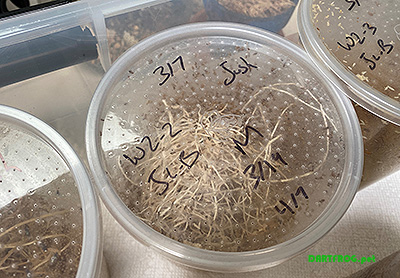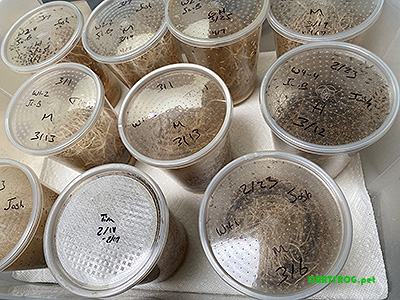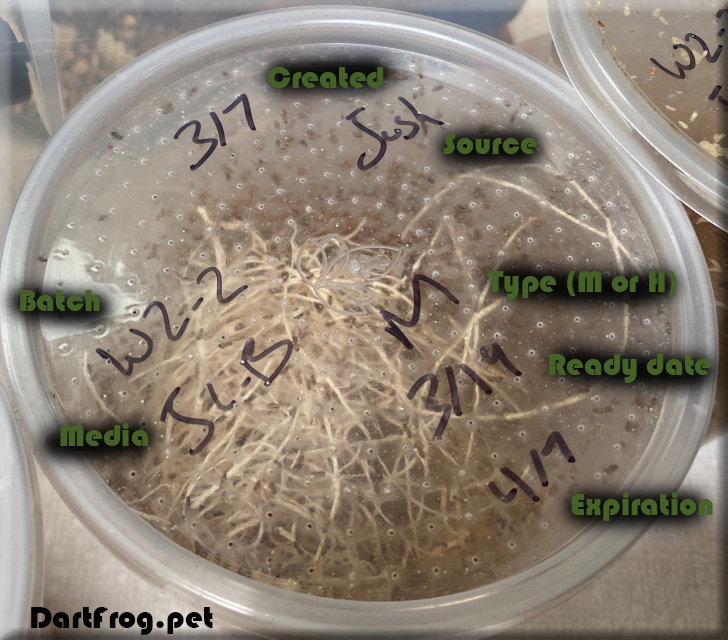


To buy or make my own?
To raise Dart Frogs successfully you you need to culture fruit flies. Temperature, mold, humidity, mites and complaints from family members regarding its odor are a few factors that can cause issues successfully raising flies. You will want to practice culturing them until you have successful produced cultures. Otherwise you might find yourself scrambling for where to buy a fruit fly culture or appropriate substitute in time to keep your frogs fed. Unlike many other animals we recommend not replying on a local pet store to "buy frog food". Even if you had a reliable store (which is rare) you would spend a pretty dime in maintaining a supply. A culture store bough might run you $6-$14. One culture will last a few weeks before it needs to be discarded before it crashes (stops producing) or becomes inundated with mites. Unlike other animals there is no "flake", "pellet", or any commercial food product that you can just buy and rely on. Frogs need to eat living food that's a size smaller than the width between its eyes. Anything wider is a choking hazard.
Fruit Fly Media Culture Simple Recipe:
Our most successful Recipe:
Ingredients per culture:
1/3 cup potato flakes (microwave to sterilize)
1/2 teaspoon cinnamon (microwave to sterilize) (fights mold)
1/4-1/8 cup brewers yeast
1/8 cup distilled white vinegar (fights mold) Increases as needed for mold issues.
1/2 teaspoon honey, (alternative 1tbls powdered sugar)
Sprinkle some Calcium plus
3/4- 1 cup Boiling water add slowly to avoid making too runny add by sight.
Fruit Fly Media Culture RICH Recipe:
Our most successful Recipe:
Ingredients per culture:
1/3 cup potato flakes (microwave to sterilize)
1/2 teaspoon cinnamon (microwave to sterilize) (fights mold)
1/4 cup brewers yeast
1/8 cup distilled white vinegar (fights mold) Increases as needed for mold issues.
1/2 teaspoon honey, (alternative 1tbls powdered sugar)
1 teaspoon Pea Protein Powder
Sprinkle some Spirulina Powder
Sprinkle some Bee Pollen Powder
Sprinkle some Chlorella Powder
Sprinkle some Calcium plus
3/4- 1 cup Boiling water add slowly to avoid making too runny add by sight.
Add honey, then some hot water to dissolve, add distilled white vinegar, brewers yeast, cinnamon, calcium and then the mash potato flakes. Finally add water and mix till an apple sauce consistency finish with a sprinkle in the brewers yeast and or Active.
Cover and allow to cool
Keep covered with a breathable material to prevent gnats or other bugs getting in while you cool. About a half hour later add your excelsior or coffee filters. Press them into your media. Add dusted fruit flies from your freshest batch of flies. Then place a lid on the container. Write the date on the lid and expiration date of 30 days from now.
When making new cultures, dust flies in calcium and or vitamins (more on that later) and use the top 20% to make new cultures. Helps prevent mites spreading as they may be more prevalent towards the bottom of the culture. Mites will be likely to fall off flies coated with calcium powder.
For issues with mold, once culture cools sprinkle active yeast atop culture mix. Increase distilled white vinegar up to 1:1 ratio to boiling water.
*Note, Hydei are more sensitive to increases in vinegar content, production slows the more vinegar present. *Note, Do not substitute distilled white vinegar with Apple cider vinegar. The nutrient load, outweighs mold retardant benefits. Studies show mold more likely to be present using ACV in cultures.
Every week produce a fresh batch of cultures. If you only need 2 cultures, produce a set of 2 cultures every week. In a given month you will have 2 weeks of cultures that are yet to produce files and 2 weeks worth of cultures that are producing flies.
A culture only lasts for a month (30 days) from when its made. Most experiences dart keepers produce two or more cultures a week to have a backup and extra flies. If your culture begins to mold, add a little more vinegar even with flies present. If your cultures appear to too runny (watery), add less water next time or use vented lids (cloth versus plastic lids with holes). If cultures are drying out use lids with holes versus the vented cloth lids. Never use solid lids or your flies will suffocate. Room/ home humidity levels will affect culture moisture so adjust the amount of your water that you add to your cultures accordingly.
Note, we do not recommend using Apple Cider Vinegar. Comparatively versus distilled white vinegar although it has a high nutrient load it has less volume of actual vinegar capable of fighting mold. Since it has a high nutrient load it will actually provide more nutrients for mold to grow. In controlled tests up to 1/8 cup of apple cider vinegar we found fungal spores thrive and spread in cultures. Comparatively at 1/8 cup of distilled white vinegar we had not spores survive within the first 7 days of culturing and direct introduction of spores.
Toss out every 30 days!
After 30 days toss out the culture. After a months time you are likely to will start generating more mites than flies! You can freeze your culture for several days to eliminate anything remaining in the culture and dump out the contents in the trash. This is recommended as you do not want living fruit flies to be introduced into your community by means of your garbage can. (Its also illegal as well to release any non-native insect or animal into the community.) Note, you can also wash your deli cup after freezing. You can easily discarding the frozen media contents and reuse the cup and lid. Vented fabric lids will need to be replaced every so often. Just rinse cups then soak cups and lids in hot water. Ideally use vinegar or 5% bleach to water solution. Using vinegar or bleach is best to kill any residual bacteria or fungi. Soap is an option, but do not use together with vinegar or bleach. Allow to air dry.
Mites: Toss out any more than a month old even though they may still be producing flies. The older a culture gets the more likely it will start producing mites. Mites are everywhere just not noticeable until their populations grow. You want to avoid having them thrive and spread in and around your cultures. Once mites bloom, they may inundate and crash our cultures. Not one culture but all of them. Mites spread quick. Mites are a base level micro fauna that seeks to cleanup any standing food. If you dont take precautions they will take hold in your fruit fly cultures, micro fauna cultures (springtails/ isopods) even your vivariums, hopefully even your kitchen (the games a foot for them). There are some things you can do to ward off mites. Keep your cultures in a plastic bin where they do not touch each other or the edges of the bin. Keep your newest cultures in a separate bin from your oldest cultures. Create a barrier around your cultures (deli cups) by placing them on a layer of Food grade Diatomaceous earth (a powder that flies cant cross) or using paper towels sprayed at least weekly with mite spray or "mite paper". Careful not to spray your cultures with the mite spray or well you will nuke them. We recommend moving cultures when spraying paper towels and allow them to dry for at least 15 minutes then place back your cultures back in the bin lined with the paper towels. Using diatomaceous earth is an easy maintenance free approach. It though can be dusty and something you don't want to inhale.

Fly Temperatures:
Keeping cultures in the upper 70F range closer to 80 degrees Fahrenheit will allow them to produce quicker than keeping in cooler temps. However warmer temps will also have cultures crash quicker too. We have a reptile warming mat above our bins in the winter to keep production optimal as culture production slows in winter months. You have about 2 weeks of time where cultures start producing flies. Having more than one producing culture is important for when one crashes (stops producing flies) so that you have another culture to fall back on so your dart frogs still have food. We have our fruit flies cultures heated by a reptile heat mat on a heat sensor that turns on when temps drop below 70F. We also provide a 10 hour light cycle using lower light output LEDs. Lighting requirements are not fully researched and can be successful without light.

How many cultures?
Scale up the number of cultures that you produce with the number of frogs that you have. A couple frogs will be supported by a single culture (and its back up). Never only produce a single culture per week. We recommend a backup. Keep in mind that the larger the frog the more fruit flies your frogs will eat. Phyllobates and Tinctorius species can eat a lot of flies at a single sitting up to 40-60 flies at a time.
Fruit fly culture labeling
So when will your flies be ready? When should I throw out my culture? What type of flies are these? Where did I get these? What's media did I use on this culture?
We recommend labeling every culture. Whether its just the date made and date expired, you want to know what's good and what's about to go bad and what needs to be thrown out? Labeling cultures saves headaches and helps maintain order to lots of culture disorder. We put as much info as will be beneficial for us on the label. Here is a sample:

On this sample culture lid we can see:
! Date! The date the culture was made.
Where we bought or where we got the initial culture from.
! Batch! The batch number. Such as week 1, 2, 3, 4 and culture number. Week-culture. Helps for journal entries if you track mold, media recipe success, etc.
Media, whether its bought or home made, it helps to know what performs and what doesn't.
Type: You don't want to grab the Melanogaster and feed the hungry Tincs small flies or grab the Hydei and feed the tiny thumbnails flies that are too big. A quick letter M or H, GH, or so forth helps for easy id of what culture is what fly.
Ready date. Typically Melanogaster flies are ready in 12 days. Hydei about 16 days. So add 12 or 16 to the date you make your culture and you will know roughly when to start using a given culture.
! Expiration date! The all important mite deterrent expiration date! 30 days after you make a culture toss it out to prevent mites from taking over the culture and neighboring cultures. When making a culture add 30 days to know when its time to throw away..
Like trying different media recipes? Are you into testing sources of fruit flies testing? Playing with various elements/ variables such as light/ dark/ hold/ cooler, et.c what makes for a better boom of flies? Make a journal. Identifying the elements that you change that lead to success allow you to record what you try and works and what doesn't work and what molds :(.. As you change media recipes document them and see how they perform. A journal is the way to document such changes.
Supplementation: Make sure to dust your flies to provide vitamins and minerals to your frogs: Supplementation details.